Gifted students often bring a wide range of unique challenges and opportunities to the classroom that aren’t always obvious at first. One student might breeze through high school algebra problems while another gets lost in the creative flow of an emotionally expressive art project. As educators, it’s important to understand the different ways giftedness shows up in our students so we can create a space where they feel seen and supported and are able to grow. This goes beyond just identifying who’s gifted. It’s also about recognizing the diverse intellectual, creative, and emotional strengths gifted kids bring to the classroom. With a better understanding of what giftedness looks like, we’re in a much better position to meet these students where they are and help them grow in meaningful ways.
Jump to:

FREE PRINTABLE
Invention Design Planning Worksheet
Challenge your gifted kids with this worksheet meant to encourage your students think outside the box and create something brand new.
What Is Giftedness?
Ask 10 different educators to define giftedness and you’ll probably get 10 different answers. That’s because giftedness isn’t a one-size-fits-all label. “The one thing we know about giftedness is its heterogeneity,” says Dr. John T. Maier, a licensed clinical social worker and Psychology Today contributor. “It shows up across ages, genders, nationalities, and almost any spectrum you can think of. In contrast, our image of what a gifted child should look or act like can sometimes be a quite narrow one.”
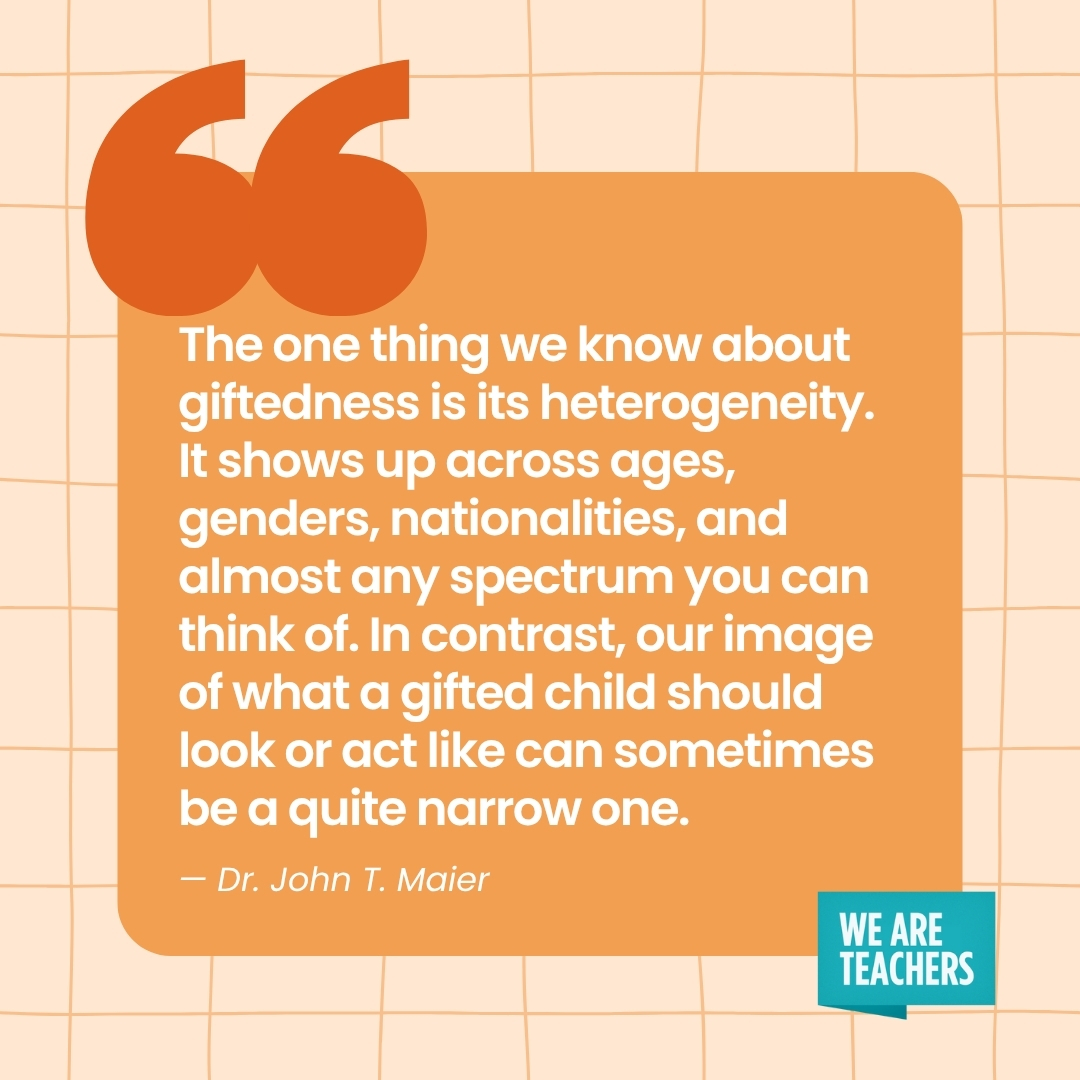
This is why gifted students can so easily be overlooked, especially if they don’t match traditional ideas of what a “gifted” child looks like. According to the National Association for Gifted Children (NAGC), gifted individuals “demonstrate outstanding levels of aptitude or competence in one or more domains.”
The Davidson Institute, a national nonprofit focused on supporting gifted youth, emphasizes that gifted kids often process information faster and more deeply than their peers. This means they may need less repetition to learn new concepts and often seek deeper understanding far beyond grade-level expectations.
Identifying giftedness usually involves a combination of standardized IQ tests (typically scoring in the top 2% to 5%), achievement assessments, classroom performance, and teacher/parent observations. These tools, while valuable, have limitations. Many gifted children, especially those from underrepresented backgrounds or with learning differences, are often overlooked.
That’s why understanding the many ways giftedness can present itself is so important. It’s not about fitting kids into a specific mold—it’s about recognizing their potential, even when it doesn’t look like what we expect.
Common Traits and Characteristics of Gifted Kids
Giftedness can be a bit of a paradox. While some gifted children are top performers in school, others underachieve or struggle socially. That’s because giftedness isn’t just about intelligence, it’s about how kids think, feel, and experience the world.
Gifted children often show unusually advanced abilities early on. They might speak in full sentences as toddlers, ask deep or complex questions, or have intense focus when exploring a topic that interests them. Just as often, however, they might be the kids who doodle while you’re teaching but can answer your questions correctly without having looked up once.
Below are some (but certainly not all!) of the traits educators commonly observe in gifted students.
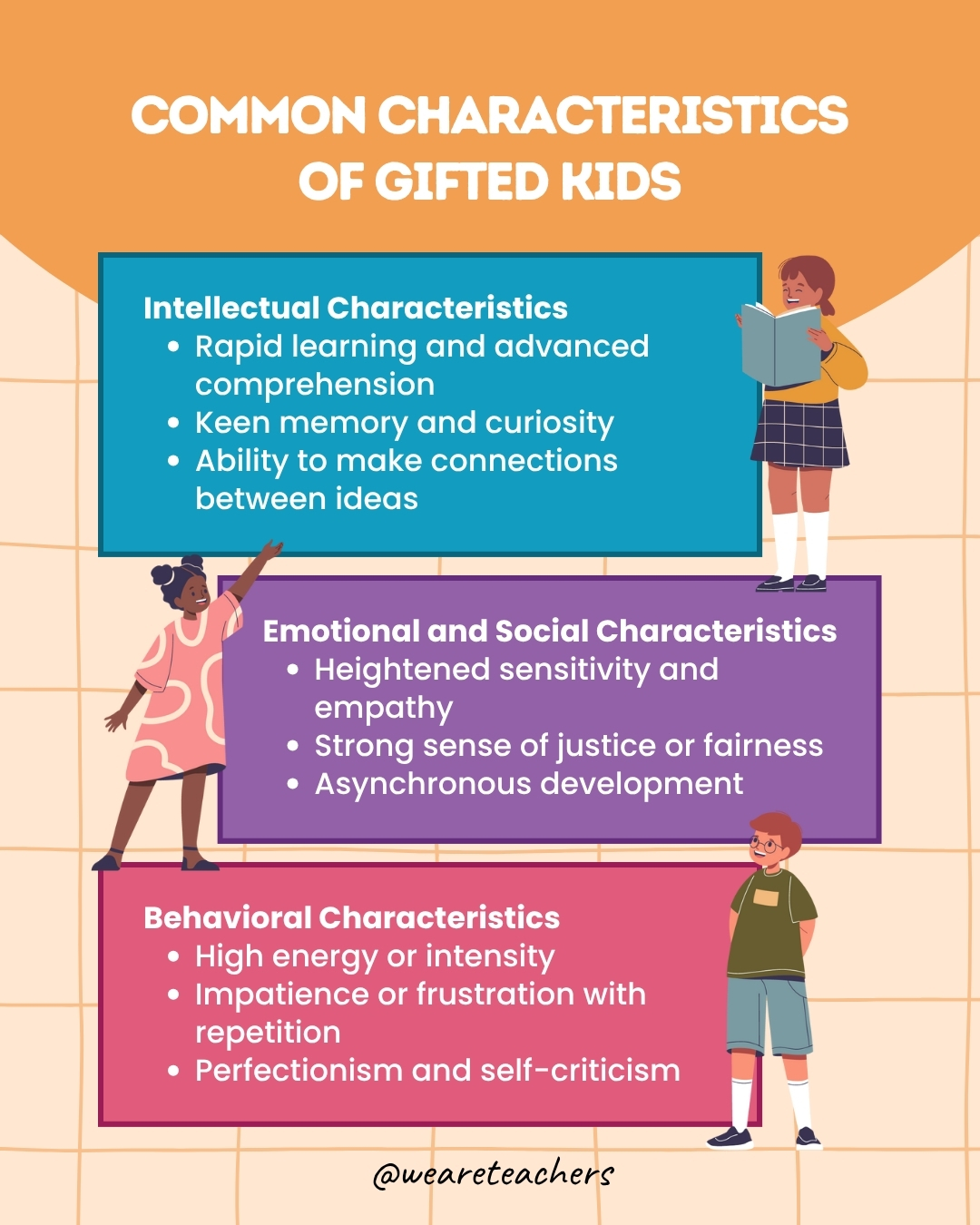
Intellectual Characteristics
- Rapid learning and advanced comprehension. Gifted kids typically grasp new concepts quickly and may need less repetition.
- Keen memory and curiosity. They often retain detailed information and ask endless “why” questions.
- Ability to make connections between ideas. You may see them leap from one idea to another in ways that feel surprising and brilliant.
Emotional and Social Characteristics
- Heightened sensitivity and empathy. Many gifted kids feel deeply, not just about their own experiences but about the world around them. They might be the first to comfort a classmate or worry about global issues.
- Strong sense of justice or fairness. You might hear gifted kids speak up when they perceive something as unfair, sometimes forcefully.
- Asynchronous development. This is the uneven growth of intellect, emotions, and physical maturity. A student might read at a high school level but have the emotional regulation of a 2nd grader.
Behavioral Characteristics
- High energy or intensity. Gifted children are often intense, not just in what they do but in how they feel.
- Impatience or frustration with repetition. They may get bored with drills or busywork and act out as a result.
- Perfectionism and self-criticism. These kids can be hard on themselves, fearing failure or avoiding challenges they can’t immediately master.
Ultimately, no two gifted children are exactly alike. The more familiar you are with these patterns, the better equipped you’ll be to recognize and support them.
6 Profiles of Gifted Learners
If being gifted can look wildly different from one student to the next, how can you identify gifted kids in your classroom? It’s not always easy (or perfect), but educators may find the Six Profiles of Gifted Learners (adapted from the work of Dr. Maureen Neihart and Dr. George Betts) useful.
Understanding these profiles can help teachers recognize and respond to giftedness in all its forms. Do you recognize any of these in your classroom?
1. The Successful Gifted Learner

- Traits: High-achieving, obedient, socially well adjusted.
- In the classroom: These students often fly under the radar because they “do everything right.” They get good grades, complete assignments, and rarely cause disruptions.
- What they need: Challenge. They may mask their true potential to meet expectations, so differentiating instruction is key to keeping them engaged and growing.
2. The Challenging Gifted Learner
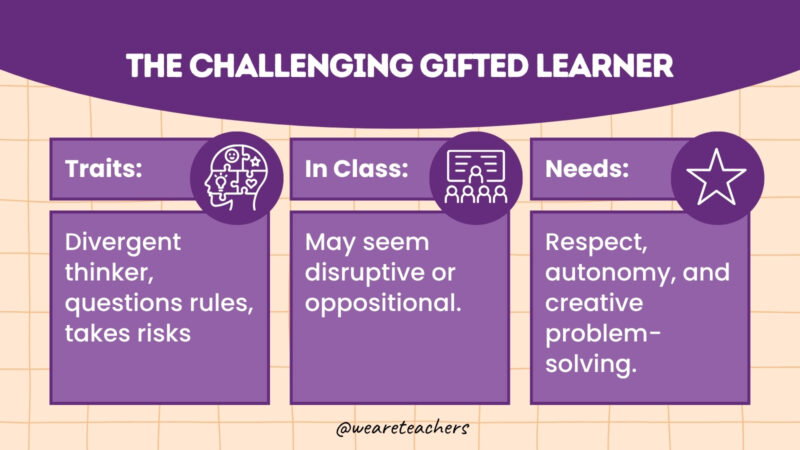
- Traits: Divergent thinker, questions rules, takes risks.
- In the classroom: This student might be mislabeled as disruptive or oppositional. They often resist routine and are energized by novelty.
- What they need: Respect for their ideas and opportunities for creative problem-solving. These learners thrive when given autonomy and authentic tasks.
3. The Underground Gifted Learner
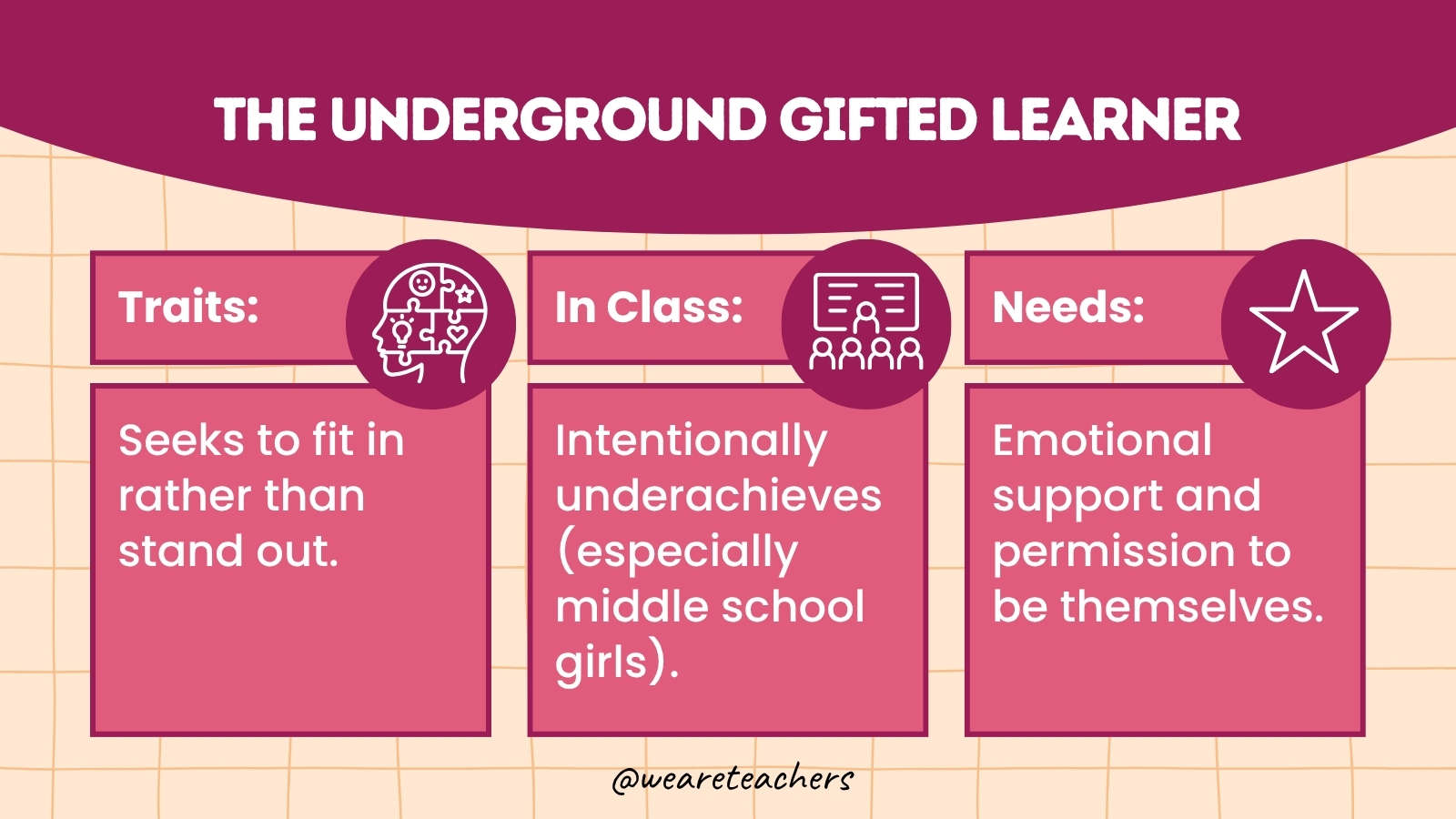
- Traits: Often seeks to “fit in” rather than stand out.
- In the classroom: Typically seen in middle school, particularly among girls and students from underserved populations. These learners may intentionally underachieve or hide their abilities to avoid social pressure.
- What they need: Emotional support and reassurance that they don’t have to choose between belonging and being themselves. A trusted adult can make a huge difference here.
4. The Dropout Learner
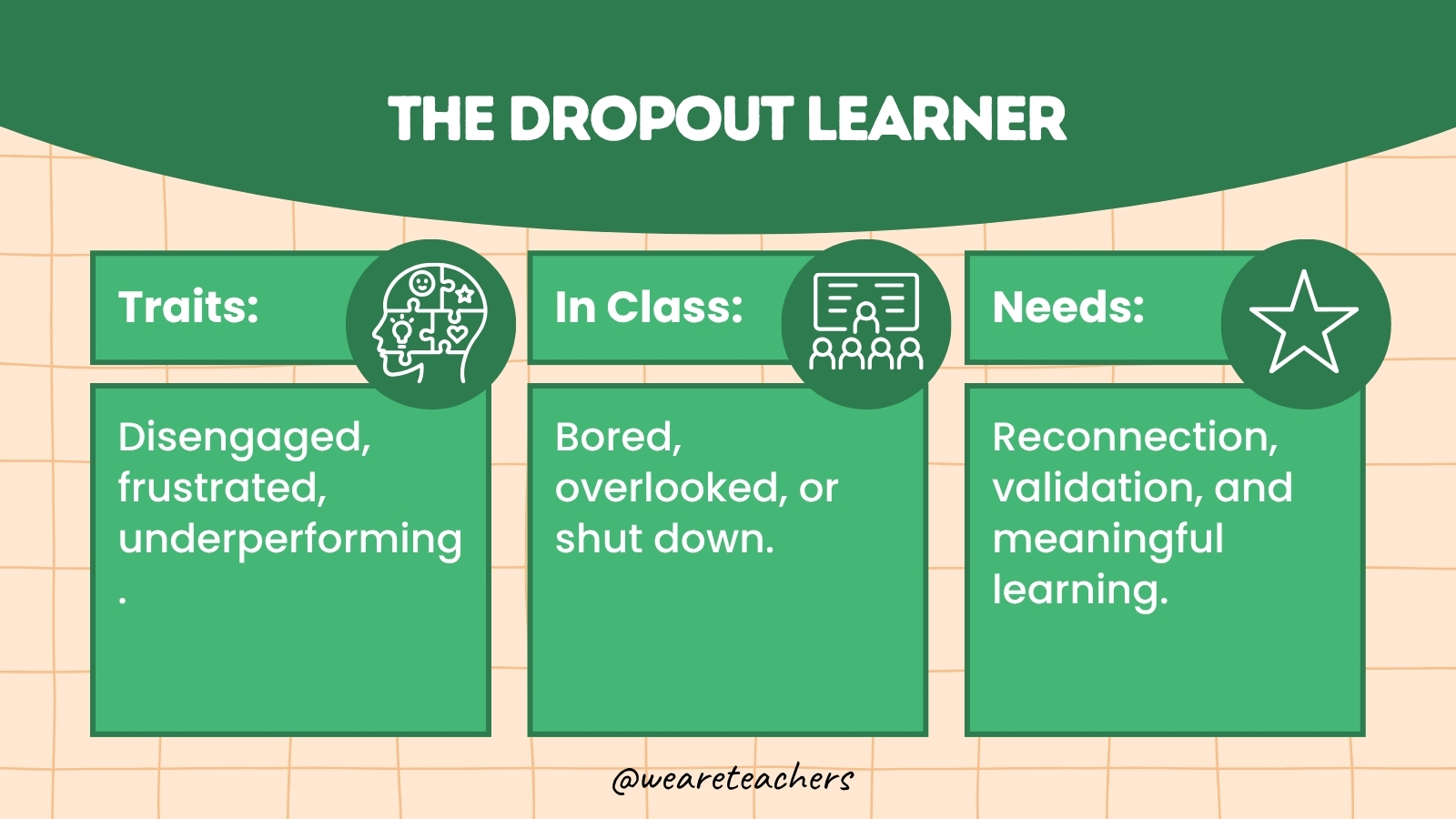
- Traits: Disengaged, frustrated, underperforming.
- In the classroom: These students are often bored, overlooked, or actively discouraged by the school system. They may have experienced repeated failure or rejection.
- What they need: Reconnection. These learners need to feel seen, heard, and valued. Building a relationship and reigniting their sense of purpose is key.
5. The Twice-Exceptional Gifted Learner (also known as “Double Labeled”)
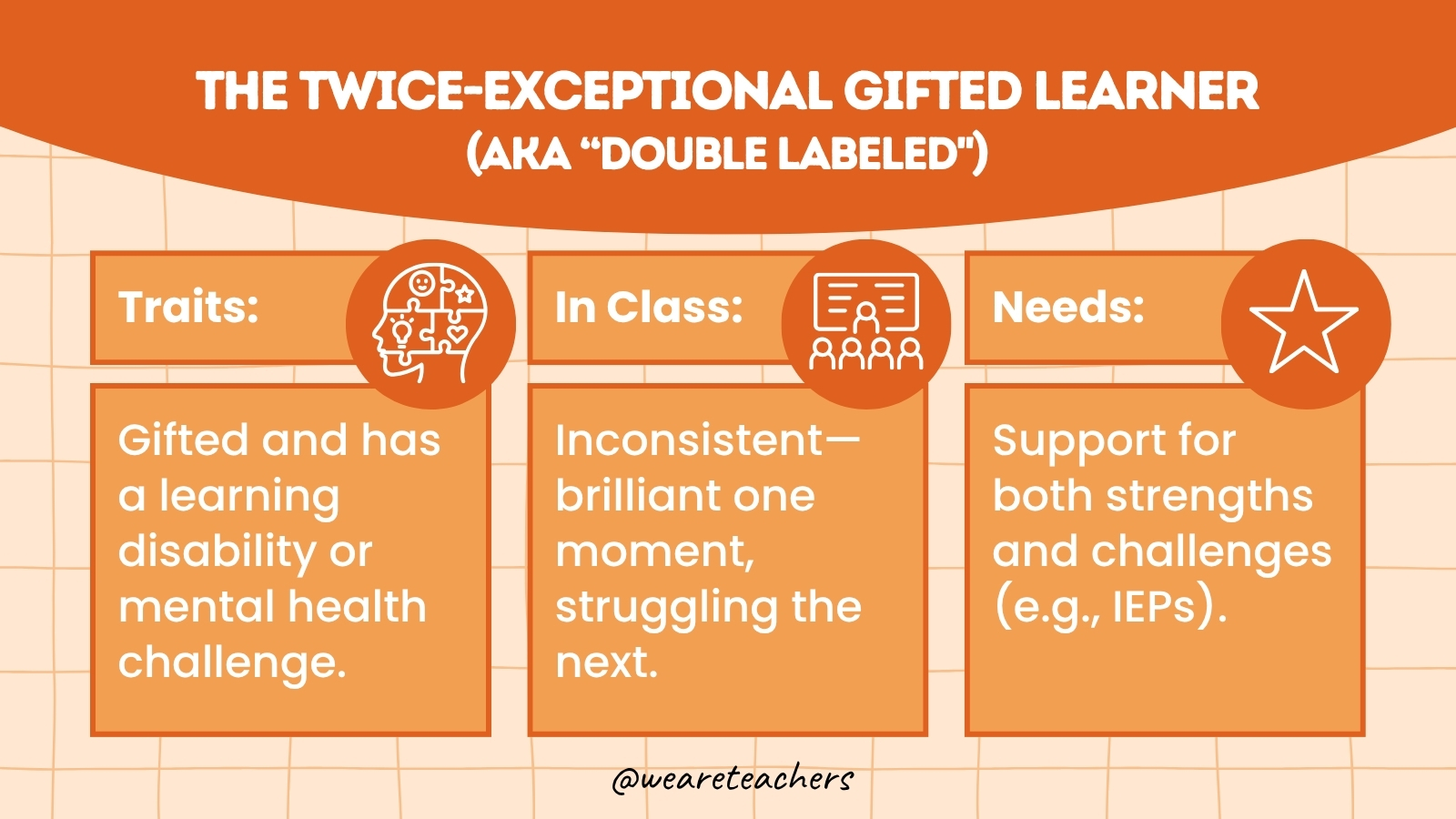
- Traits: Gifted and has a learning disability or mental health challenge.
- In the classroom: These students often appear inconsistent—brilliant in one moment, struggling the next. They may be seen as lazy, inattentive, or disorganized.
- What they need: A dual approach that nurtures strengths while providing support for their challenges. Think: IEPs that account for both giftedness and learning differences.
6. The Autonomous Gifted Learner

- Traits: Independent, intrinsically motivated, self-directed.
- In the classroom: These are the students who dive into passion projects, go above and beyond, and set their own goals.
- What they need: Flexibility and mentorship. Let them explore subjects deeply and at their own pace. Project-based learning often works well for them.
According to the Davidson Institute and Mid-South Gifted Academy, these profiles aren’t rigid boxes. Students may shift between types over time or display characteristics of more than one profile. Instead, these profiles offer a powerful lens for teachers trying to understand why a gifted child may not “look” gifted.
Types of Giftedness
When we talk about gifted kids, people often think of a child excelling in math or reading. Giftedness doesn’t fit neatly into just one category, though. It shows up in many forms and in varying degrees of intensity. Dr. Deborah Ruf, a gifted-education specialist, identified five levels of giftedness to help illustrate just how broad the range can be.
Deborah Ruf’s 5 Levels of Giftedness
Level 1: Moderately Gifted
These students are curious and bright, often at the top of their class, and may need occasional enrichment.
Level 2: Highly Gifted
They show advanced reading, learning, and problem-solving skills, and typically need regular differentiation to stay engaged.
Level 3: Exceptionally Gifted
These children learn rapidly and may need an accelerated or specialized curriculum to thrive.
Level 4: Profoundly Gifted
They often test at the 99.9th percentile and may experience extreme asynchrony. The intellectual capacity of this type of gifted kids is far beyond their emotional or physical age.
Level 5: Exceptionally Rare
These students require highly individualized education and often struggle to find intellectual peers. They’re the students who may teach themselves algebra in early elementary school or read at a high school level in kindergarten.
Understanding these levels reminds us that not all gifted kids need the same support. Some need enrichment, while others need full acceleration or radically different instruction.
Multiple Domains of Giftedness
Beyond cognitive ability, giftedness may emerge in several key areas. Here are a few domains of giftedness that teachers can watch for in the classroom:
- Academic: Advanced knowledge and understanding in subjects like math, science, or language arts.
- Creative: Original thinking, imagination, and problem-solving in unique or unusual ways.
- Leadership: Natural ability to influence others, take initiative, and organize people or ideas.
- Psychomotor: Exceptional athletic or physical skill development (often overlooked in academic settings).
- Emotional or social: Deep empathy, insight, or moral reasoning well beyond their years.
This broader understanding is crucial. A student with a vivid imagination and deep emotional insight may be just as gifted as one with a precocious reading level. Yet only one may be formally identified if we’re not looking carefully.
Recognizing these varied expressions of giftedness helps educators better support the whole child and ensures we don’t miss brilliant kids simply because their gifts don’t look the way we expect.

Challenges Gifted Kids Face
At first glance, being gifted might seem like an educational advantage—and it can be. It’s crucial to recognize that giftedness also comes with unique challenges that can impact a child’s academic performance, emotional well-being, and social development. In fact, some of the biggest struggles teachers observe in their classrooms are directly linked to the very traits that define giftedness.
Perfectionism and Anxiety
Gifted students often set impossibly high standards for themselves. They may become anxious when they don’t immediately master something or avoid tasks altogether for fear of failure. According to a study published in the Journal of Education and Learning, many gifted children internalize perfectionistic expectations, which can result in chronic stress and emotional exhaustion.
Asynchronous Development
Gifted kids often develop intellectually faster than they do socially or emotionally. This mismatch, called asynchronous development, can lead to frustration, isolation, or confusion, especially when they’re expected to “act their age” while processing the world like a much older person.
You might see a student who can discuss abstract philosophical ideas but breaks down in tears over a minor disagreement with a friend. It’s not inconsistency, it’s asynchrony.
Social Isolation and Feeling “Different”
Many gifted students feel out of step with their peers, especially when their interests, vocabulary, or humor don’t align with classmates. Some may isolate themselves or try to hide their abilities to fit in. The Davidson Institute and Advanced Psychology Services both highlight how this social disconnect can lead to loneliness, depression, or behavioral issues if not addressed.
Misdiagnosis and Twice-Exceptionality
Some gifted students also have ADHD, autism, dyslexia, or other learning or behavioral differences. These twice-exceptional (2e) kids often get overlooked or misdiagnosed. Their giftedness may mask their struggles, or vice versa, leading to inconsistent performance and misunderstood behaviors.
“The relationship between giftedness and ADHD is complicated,” Dr. Maier explains. “Many children have both diagnoses—but the two can also be mistaken for one another. This is an area where it makes sense to consult with a mental health professional with experience working with children and adolescents—ADHD is a highly manageable condition, and behavioral therapy is a first-line and effective treatment.”
Underachievement and Boredom
Gifted students who aren’t sufficiently challenged can become disengaged, leading to underachievement. As the Davidson Institute highlights, boredom and lack of appropriate stimulation are common challenges gifted learners face, particularly when curriculum isn’t matched to their abilities.
Similarly, the NAGC emphasizes that unchallenging classrooms can lead to frustration and underperformance. Recognizing and addressing these issues is crucial for educators to help gifted students reach their full potential.
Teachers are often the first line of defense in spotting these struggles. With greater awareness of these common challenges, educators can shift their approach from managing behaviors to meeting needs. Sometimes even small changes can make a big difference.
Why This Matters for Teachers
Gifted students need something different. The first step to giving them what they need is understanding who they are. When teachers recognize the full range of gifted profiles and traits, it opens the door to deeper engagement, fewer behavior issues, and more inclusive classrooms.
Gifted Kids May Be in Your Classroom
Some students are formally identified as gifted through testing and evaluations, but many others go unnoticed. This is especially true for students from underrepresented backgrounds, English language learners, and those with disabilities. Teachers who understand how giftedness can look in different forms are more likely to recognize it in their students. This is incredibly important to ensure that these kids get the support they need.
Differentiation Makes a Big Difference
Gifted students need more than busywork or bonus problems. They need learning experiences that match their readiness, interests, and learning pace. Without thoughtful differentiation, many gifted kids become bored, act out, or disengage entirely.
That’s why it’s so important to differentiate both the pace and depth of instruction. Here’s what that can look like in practice:
What Not To Do
- Don’t assign more of the same. Giving 20 extra math problems to a child who finishes early isn’t enrichment, it’s a penalty.
- Don’t expect perfection or flawless behavior. Gifted students often experience asynchronous development. They may be able to solve algebraic equations in their head but have trouble regulating emotions.
- Don’t assume gifted = gifted in everything. A student may read at a high school level but struggle with writing. Giftedness is often domain-specific.
- Don’t isolate them. Sending them to the back of the room or the computer lab without guidance isn’t support. It’s exclusion.
- Don’t use them as helpers or tutors. Gifted kids need challenge, not extra responsibility without benefit.
“Enrichment programs can be excellent, and they do not need to be specifically targeted at ‘gifted’ children,” Dr. Maier notes. “Odyssey of the Mind (which I’ve been involved with as a participant and judge) is a great example of an extracurricular program that teaches problem-solving and teamwork and is open to everyone, whether or not they identify as gifted. OM and similar programs have much to offer gifted children and their parents.”
What To Do Instead
- Identify areas of strength. Use assessments (formal and informal) to pinpoint where a student is gifted, and plan targeted enrichment or acceleration.
- Provide content-rich, high-level tasks. Give students access to deeper, more complex material—not just creative “add-ons” or early finisher worksheets.
- Group them with intellectual peers. This could be ability-based groupings, school-wide talent programs, or external opportunities like summer enrichment programs.
- Offer choice and voice. Let students explore passion projects, real-world problems, or interdisciplinary themes tied to their interests.
- Keep learning yourself. Seek training in gifted education, connect with advocacy networks, and explore research-based curriculum units (like those developed through the Javits Program).
Gifted students thrive when their potential is recognized and supported through more meaningful learning opportunities. Teachers who understand this population and provide appropriate differentiation aren’t just meeting needs, they’re setting kids up for long-term success.
Understanding Helps With Behavior Management
Many classroom challenges tied to gifted students, such as boredom, noncompliance, and impulsivity, are actually signs of unmet needs. When teachers recognize that a student is acting out because they’re underchallenged or emotionally overwhelmed, the response shifts from discipline to support.
Teachers Are Often the Strongest Advocates
Even in schools with strong gifted programs, teachers are often the ones who notice when a student’s needs aren’t being met. Knowing what to look for, and being able to articulate it to families and administrators, gives teachers more power to advocate effectively.
Professional Growth and Joy in Teaching
Understanding gifted learners often reignites a teacher’s own love for learning. These students can be surprising, challenging, and exhilarating to teach. When educators are equipped to support them, it makes the whole classroom better.
Gifted kids don’t always raise their hands or ace every test, but when you look a little closer, you’ll see sparks of brilliance waiting to be nurtured. That begins with awareness, empathy, and a willingness to see beyond the surface.
Special thanks to Dr. John T. Maier for his contribution to this article. He is a psychotherapist in private practice in Cambridge, Massachusetts, and also teaches philosophy at Lesley University and Simmons University. You can learn more about his work on his Psychology Today profile or visit his personal website for information about his books, research, and essays.
Get my invention design planning worksheet!
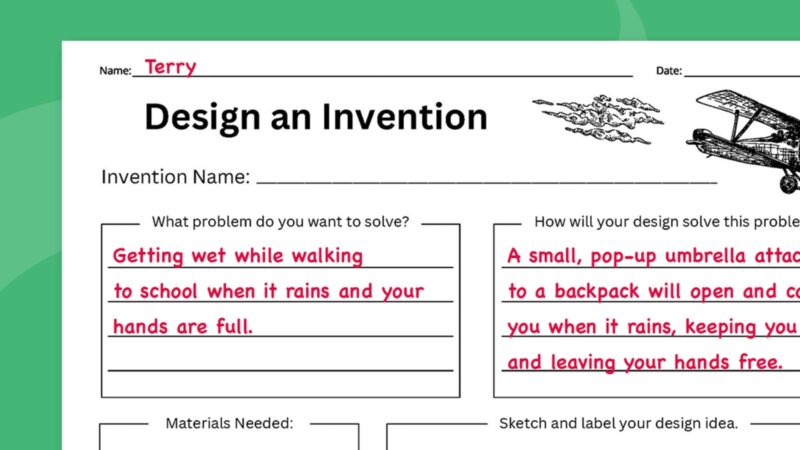
Want to challenge your gifted kids? We put together an easy-to-use invention planning worksheet to help students brainstorm great ideas and work through the steps of the design process.
Do you see gifted kids in your classroom? Come share your thoughts and ideas in the We Are Teachers HELPLINE group on Facebook.
For more articles like this, subscribe to our newsletters to find out when they’re posted!



